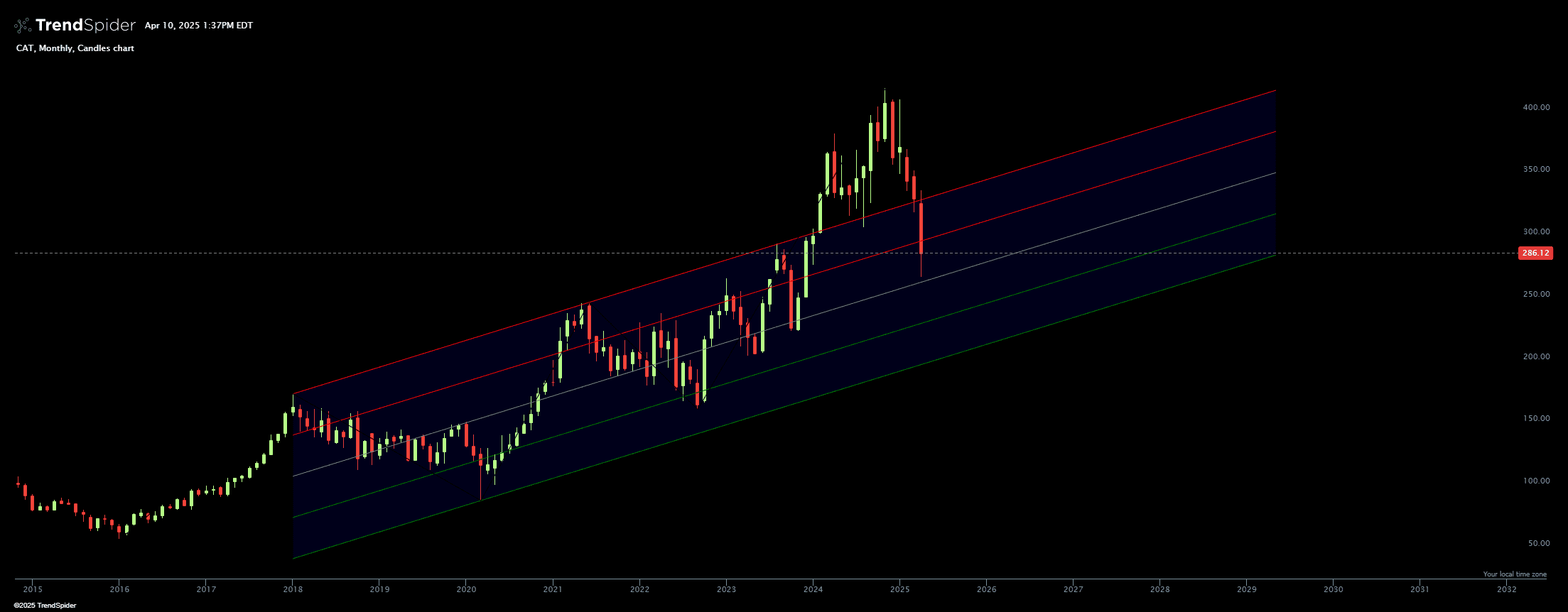Zig Zag Channel with Settings

This indicator paints a channel on your channel using the Zig Zag Levels as anchor points. You can adjust which Zig Zag Levels are being used to anchor the channel via the Position setting. To get more information on Depth, Deviation, and Backstep, please refer to our documentation on the ZigZag indicator from the Knowledge Base.
Source code
This indicator had been implemented by TrendSpider Team in JavaScript on TrendSpider. Check out the developer documentation to learn more about JS on TrendSpider.
// This indicator code was generated using AI. It was not checked by Quality Assurance
// and did not pass any quality assurance processes that we normally would use at TrendSpider
// As a result, we can’t guarantee that it will operate as expected in all cases and you should
// use caution when using this indicator. Consider it for informational purposes only.
describe_indicator("Zig Zag Channel with Settings");
let position = input.select('Position', 'auto', ['auto', 0, 1, 2, 3, 4, 5]);
const depth = input.number('Depth', 20);
const deviation = input.number('Deviation', 1);
const backstep = input.number('Backstep', 2);
// Get zig zag points with the default parameters
const zigZagPointsObject = zigzag_points(depth, deviation, backstep);
// Define the series in which we will merge the high and low zigzag points
const zigZagPoints = series_of(null);
// Assign the high value in the indexes of high zig zag points
zigZagPointsObject.highIndexes.forEach(pointIndex => zigZagPoints[pointIndex] = high[pointIndex]);
// Assign the low value in the indexes of low zig zag points
zigZagPointsObject.lowIndexes.forEach(pointIndex => zigZagPoints[pointIndex] = low[pointIndex]);
// Connect the points with lines
const zigZagLine = interpolate_sparse_series(zigZagPoints);
// Get indexed points of Zig Zag so that we can get the points
const indexedPointsOfZigZag = indexed_points_of(zigZagPoints);
assert(indexedPointsOfZigZag && indexedPointsOfZigZag.length > 3, `Not enough zig zag points. Try loading more candles or changing timeframe`);
const computeChannel = position => {
assert(position < indexedPointsOfZigZag.length - 3, `Not enough zig zag points for this position. Try lower position number.`);
// Get the points
const A = indexedPointsOfZigZag[indexedPointsOfZigZag.length - position - 3];
const B = indexedPointsOfZigZag[indexedPointsOfZigZag.length - position - 2];
const C = indexedPointsOfZigZag[indexedPointsOfZigZag.length - position - 1];
// Get start index
const startIndex = A.candleIndex;
// Compute line starting from A and through C
const line1 = line(A.candleIndex, A.value, C.candleIndex, C.value);
// Compute distance between the line and the B Zig Zag point
const distanceBetweenLineACandB = B.value - line1[B.candleIndex];
// Compute second line
const line2 = add(line1, distanceBetweenLineACandB);
// Compute middle line
const middleLine = add(line1, distanceBetweenLineACandB / 2);
// Compute quarter lines
const line3 = add(line1, distanceBetweenLineACandB / 4);
const line4 = add(line1, 3 * distanceBetweenLineACandB / 4);
// Rename lines according to their position
let topLine = [];
let bottomLine = [];
let upperQuarterLine = [];
let lowerQuarterLine = [];
const APointIsHigh = A.value > B.value;
if (APointIsHigh) {
topLine = line1;
bottomLine = line2;
upperQuarterLine = line3;
lowerQuarterLine = line4;
} else {
topLine = line2;
bottomLine = line1;
upperQuarterLine = line4;
lowerQuarterLine = line3;
}
return {topLine, bottomLine, upperQuarterLine, lowerQuarterLine, middleLine, startIndex};
}
let channelObject = {};
if (position == 'auto') {
const lastIndex = close.length - 1;
position = 0;
while (position < indexedPointsOfZigZag.length - 3) {
const testChannel = computeChannel(position + 1);
const lastCloseIsNotInTheChannel = (testChannel.topLine[lastIndex] < close[lastIndex]) || (testChannel.bottomLine[lastIndex] > close[lastIndex]);
if (lastCloseIsNotInTheChannel) {
break;
}
position++;
}
}
channelObject = computeChannel(position);
const {topLine, bottomLine, upperQuarterLine, lowerQuarterLine, middleLine, startIndex} = computeChannel(position);
const topLineRef = paint(topLine, 'Top Line', 'red');
const bottomLineRef = paint(bottomLine, 'Bottom Line', 'green');
fill(
topLineRef,
bottomLineRef,
'blue',
0.1
)
const middleLineRef = paint(middleLine, 'Middle Line', 'grey');
const upperQuarterLineRef = paint(upperQuarterLine, 'Upper Quarter Line', 'red');
const lowerQuarterLineRef = paint(lowerQuarterLine, 'Lower Quarter Line', 'green');
paint(zigZagLine, 'ZigZag Line', 'black');
// Paint projections
const getProjectionSeries = originalLine =>
add(shift(originalLine, -startIndex), originalLine[originalLine.length-1] - originalLine[startIndex]);
fill(
paint_projection(topLineRef, getProjectionSeries(topLine)),
paint_projection(bottomLineRef, getProjectionSeries(bottomLine)),
'blue',
0.1
)
paint_projection(middleLineRef, getProjectionSeries(middleLine));
paint_projection(upperQuarterLineRef, getProjectionSeries(upperQuarterLine));
paint_projection(lowerQuarterLineRef, getProjectionSeries(lowerQuarterLine));
